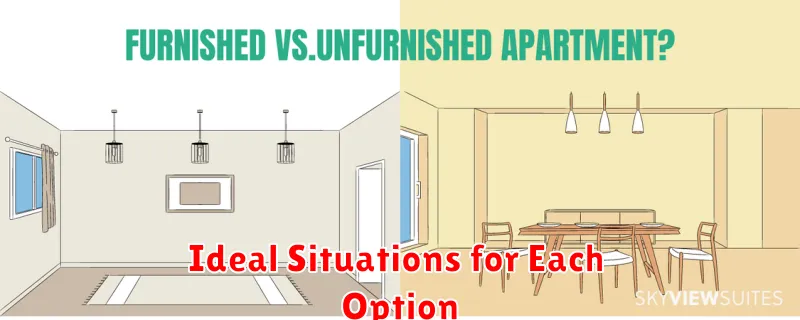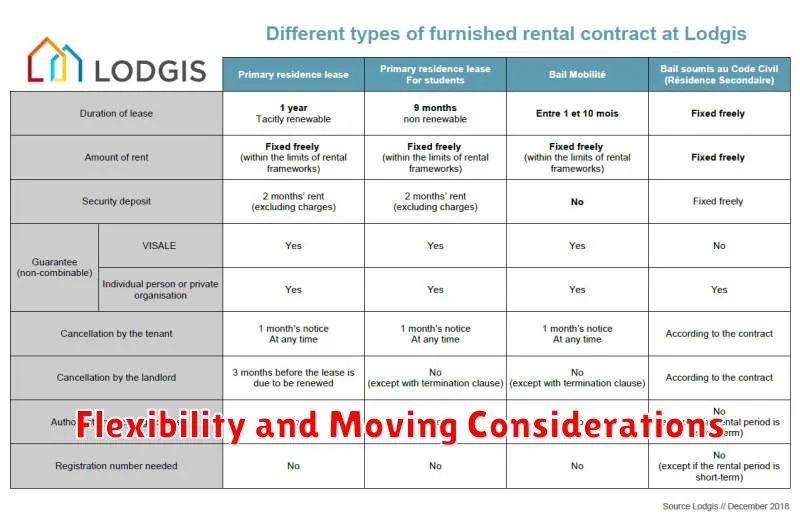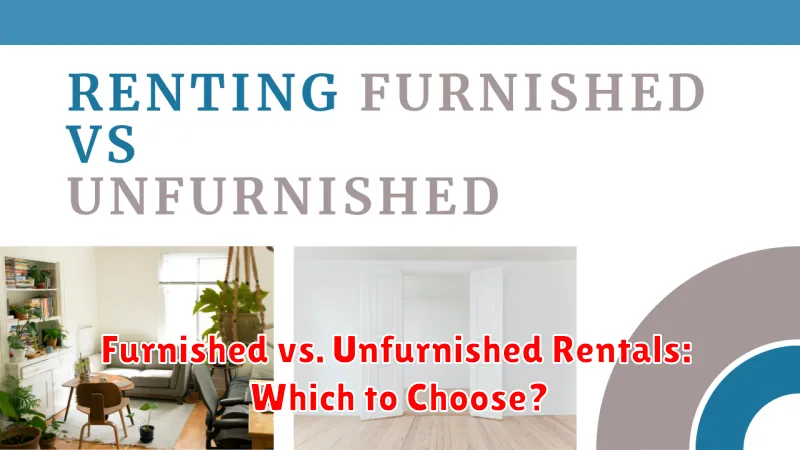Choosing between furnished and unfurnished rentals can be a significant decision when searching for a new place to live. This choice impacts not only your moving process but also your overall budget and lifestyle. Whether you’re a seasoned renter or a first-timer, understanding the pros and cons of both furnished apartments and unfurnished apartments is crucial for making the right choice for your needs. This article will explore the key differences between furnished and unfurnished rentals, taking into account factors such as cost, convenience, and personal preferences.
From the flexibility of decorating in unfurnished apartments to the ease of move-in that furnished apartments offer, we’ll delve into the advantages and disadvantages of each option. By considering your individual circumstances, lease terms, and priorities, you can determine whether a furnished rental or an unfurnished rental is the ideal fit for your lifestyle and budget. We’ll guide you through the key considerations, helping you make an informed decision about whether a furnished or unfurnished apartment is the best choice for you.
Key Differences Between Furnished and Unfurnished
The primary difference between furnished and unfurnished rentals lies in the inclusion of furniture. A furnished property comes equipped with essential furniture pieces like a bed, sofa, table, chairs, and often includes basic appliances such as a refrigerator, stove, and oven. The specific items can vary, so it’s crucial to clarify with the landlord or property manager exactly what is included in the lease agreement. Furnished apartments are often favored by those seeking short-term accommodations, students, or individuals relocating who haven’t yet acquired their own furniture.
An unfurnished rental, in contrast, provides only the bare essentials. This typically includes built-in appliances like a stove and oven, and sometimes a refrigerator. It does not include furniture of any kind. Renters are responsible for providing their own furnishings, which offers greater flexibility in terms of personal style and customization. Unfurnished rentals are generally preferred by those looking for longer-term accommodations and who have their own furniture.
The cost difference is another important factor. Furnished apartments typically command a higher monthly rent due to the added convenience and cost of providing furniture. Unfurnished rentals tend to be more affordable in terms of monthly rent, but renters must factor in the expense of purchasing or renting their own furniture. Ultimately, the best choice depends on individual needs, budget, and the length of the intended stay.
Cost Comparison and Upfront Investment
When comparing costs, it’s important to consider both upfront investment and long-term expenses. Upfront investment typically includes the initial purchase price, installation fees, and any necessary training costs. While a lower upfront cost may seem attractive, it’s crucial to weigh it against the potential for higher long-term costs such as maintenance, repairs, and operating expenses.
A higher initial investment may offer better long-term value due to increased efficiency, reduced maintenance needs, or advanced features that save money over time. For example, a more expensive, energy-efficient appliance may have a higher upfront cost but lower operating costs, ultimately resulting in savings over its lifespan. Conversely, a cheaper alternative may require more frequent repairs or consume more energy, leading to higher expenses in the long run.
Conducting a thorough cost comparison that considers both short-term and long-term expenses is essential for making informed decisions and maximizing return on investment.
Ideal Situations for Each Option

Choosing the right option depends heavily on the specific context. For simple tasks with predictable outcomes, automated solutions are often ideal. These situations benefit from the speed and consistency of automation, minimizing manual effort and reducing the risk of human error. Examples include repetitive data entry, automated email responses, and scheduled backups.
When dealing with complex tasks requiring judgment, creativity, or empathy, human intervention is crucial. These scenarios demand nuanced understanding and adaptability, which are strengths of human intelligence. Examples include customer service interactions, content creation, and strategic decision-making.
A hybrid approach, combining automation and human input, can be the most effective solution for many situations. This approach leverages the strengths of both, allowing automation to handle routine tasks while humans focus on more complex aspects. This model is often seen in areas like social media management, where automated posting is combined with human interaction in comments and direct messages.
Flexibility and Moving Considerations

Flexibility is paramount when considering a move. Being open to different locations, dates, and even housing types can significantly ease the process and potentially reduce costs. Compromise is often key. For example, if proximity to work is a priority, you may need to be flexible on budget or square footage. Similarly, sticking to a strict moving date could limit available options and inflate prices.
Moving considerations encompass a wide range of factors beyond just the physical relocation of belongings. These include researching the new area (schools, amenities, cost of living), setting a realistic budget that includes not only moving expenses but also initial setup costs in the new home, and establishing a timeline for packing, transportation, and settling in. Advance planning helps mitigate stress and ensures a smoother transition.
Finally, remember the importance of research and due diligence. Thoroughly vet moving companies, compare quotes, and read reviews. Understand the terms and conditions of your lease or purchase agreement. Being informed and prepared empowers you to make the best decisions for your specific circumstances.
Resale and Storage of Personal Furniture
Reselling furniture can be a practical way to recoup some of the initial investment and declutter your home. Several options exist, including online marketplaces, consignment shops, and local classifieds. When preparing furniture for resale, it’s essential to clean it thoroughly and address any minor repairs to maximize its appeal and potential resale value. Accurately describing the item’s condition and dimensions is also crucial for a smooth transaction.
Storing furniture is often necessary during moves, renovations, or when downsizing. Choosing the right storage solution depends on the duration and type of furniture being stored. Climate-controlled units are ideal for delicate or antique pieces to protect them from humidity and temperature fluctuations. Properly wrapping and padding furniture with protective materials like blankets and bubble wrap helps prevent scratches and damage during transport and storage.
Whether reselling or storing, planning is key. Researching current market values for resale and comparing storage facility prices and services can help you make informed decisions. Taking an inventory of items with photos and descriptions is also helpful for insurance purposes and can assist with organization and retrieval later on.
Lease Terms and Damage Liability
Lease terms outline the responsibilities of both the landlord and tenant for the duration of the rental agreement. These terms include the lease duration, rent amount, payment schedule, and acceptable use of the property. Understanding and adhering to these terms is crucial to a successful landlord-tenant relationship. Breach of contract can occur if either party violates the agreed-upon terms, potentially leading to legal action.
Damage liability typically addresses responsibility for repairs to the property. Normal wear and tear is generally the landlord’s responsibility, while damage caused by the tenant’s negligence or intentional acts is the tenant’s responsibility. It is important to clearly document the condition of the property at the beginning and end of the lease term to avoid disputes. This documentation often involves a move-in and move-out inspection, including photographs or videos.
Both parties should carefully review the lease agreement before signing. If any terms regarding damage liability are unclear, it is advisable to seek clarification. A clear understanding of the lease terms and damage liability helps to protect both the landlord’s investment and the tenant’s security deposit.
Making the Right Choice for Your Needs
Choosing the right product or service can be overwhelming. It’s important to carefully consider your specific needs and budget before making a decision. Researching different options and comparing features is crucial for finding the best fit. Consider factors like performance, reliability, and customer support to ensure a satisfactory experience.
Don’t be afraid to ask for recommendations from trusted sources or read online reviews. Understanding the pros and cons of each option will help you narrow down your choices. Prioritize the features that are most important to you, and don’t be swayed by unnecessary extras that might inflate the price.
Ultimately, the right choice is the one that best meets your individual requirements. By taking the time to evaluate your options and make an informed decision, you can increase your chances of satisfaction and avoid buyer’s remorse.

